The Rio Grande Ranch Headquarters Historic District is a historic one-story residence located 3 miles (4.8 km) east of Okay in Wagoner County, Oklahoma. The site was listed on the National Register of Historic Places September 9, 1992. The site's Period of Significance is 1910 to 1935, and it qualified for listing under NRHP criteria A and C.

The Thomas R. McGuire House, located at 114 Rice Street in the Capitol View Historic District of Little Rock, Arkansas, is a unique interpretation of the Colonial Revival style of architecture. Built by Thomas R. McGuire, a master machinist with the Iron Mountain and Southern Railroad, it is the finest example of the architectural style in the turn-of-the-century neighborhood. It is rendered from hand-crafted or locally manufactured materials and serves as a triumph in concrete block construction. Significant for both its architecture and engineering, the property was placed on the National Register of Historic Places on December 19, 1991.

Beth David Synagogue, formally Congregation Beth David, is a Reform Jewish congregation and synagogue located at 3344 East Main Street in the hamlet of Amenia, New York, in the United States. It is a small brick European-style building erected in the late 1920s.

The Clackamas Lake Ranger Station Historic District is a Forest Service compound consisting of eleven historic buildings located in the Mount Hood National Forest in the Cascade Mountains of northern Oregon. It was originally built as a district ranger station for the Clackamas Lake Ranger District. It was later converted to a summer guard station. Today, the Forest Service rents the historic ranger's residence to recreational visitors. The Clackamas Lake Ranger Station is listed as a historic district on the National Register of Historic Places.

The James A. Redden Federal Courthouse, formerly the United States Post Office and Courthouse, is a federal courthouse located in Medford, Jackson County, Oregon, United States. Completed in 1916 under the supervision of architect Oscar Wenderoth, it houses the United States District Court for the District of Oregon. A substantial extension was completed in 1940, under the supervision of architect, Louis A. Simon. In September 1996, the United States Senate enacted a bill introduced by Oregon Senator Mark Hatfield to rename the building for long-serving District Court judge James A. Redden.
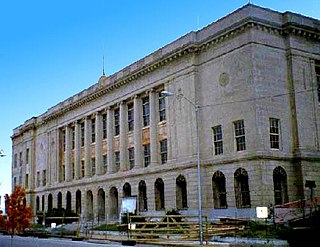
The Ed Edmondson United States Courthouse, previously called the Muskogee Federal Building- United States Courthouse, is a historic government building in Muskogee, Oklahoma. It was built in 1915 as a post office and federal courthouse. Although it is no longer used as a post office, it is currently in use by several government offices, including the U.S. Marshals and U.S. Probation Office as well as the United States District Court for the Eastern District of Oklahoma.

The Lake of the Woods Ranger Station is a United States Forest Service compound consisting of eight buildings overlooking Lake of the Woods in the Fremont-Winema National Forests of southern Oregon. All of the ranger station structures were built by the Civilian Conservation Corps between 1937 and 1939. Today, the compound serves as a Forest Service work center, and the old ranger station office is a visitor center. The ranger station is listed on the National Register of Historic Places.
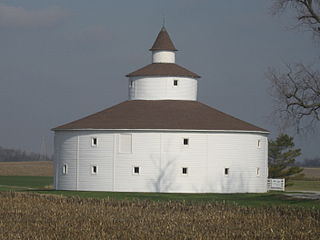
The Strauther Pleak Round Barn, also known as the "Pleak-Morgan Barn", is a round barn near Greensburg, Indiana, United States in Washington Township. Built in 1914, it was listed on the National Register of Historic Places in 1993. The barn is part of farmstead with a circa 1940 Indiana limestone ranch house, smoke house, spring house and garage. The main drive is looped enclosing a pen with a chicken coop and smaller barn.

Jackson Park Town Site Addition Brick Row is a group of three historic houses and two frame garages located on the west side of the 300 block of South Third Street in Lander, Wyoming. Two of the homes were built in 1917, and the third in 1919. The properties were added to the National Register of Historic Places on February 27, 2003.
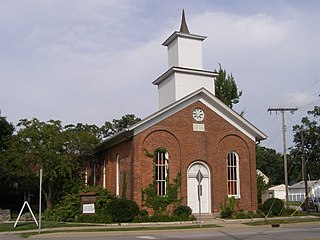
First Unitarian Church of Hobart is the oldest Unitarian Church in Indiana, and the oldest church still occupied by its original congregation in the city of Hobart. It was added to the National Register of Historic Places on September 9, 1999.

Buford Tower is a tower standing along the north shore of Lady Bird Lake in downtown Austin, Texas. The structure was originally built in 1930 as a drill tower for the Austin Fire Department, but it now serves as a bell tower and landmark. Named after fire department Captain James L. Buford, the structure has been listed on the National Register of Historic Places since 2016.

The Bowers Harbor Inn is a restaurant located at 13512 Peninsula Drive in Peninsula Township, Michigan. It was constructed in 1928 as a private house, the Stickney Summer House, and renovated into the restaurant in the late 1950s; it now houses the Mission Table and Jolly Pumpkin Restaurants. The site overlooks the waters of Bowers Harbor, an inlet of Grand Traverse Bay. It was listed on the National Register of Historic Places in 2011.
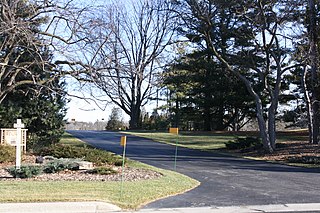
Windway is an historic residential property located north of Kohler, Wisconsin. It was built in 1937–1938 by Walter J. Kohler, Jr., future governor of Wisconsin and an executive of the Kohler Company.

The Everel S. Smith House is located on the northeast corner of West Jefferson Street and Clyborn Avenue in Westville, Indiana and is set well back from the streets it fronts. The yard is landscaped with four large maples and one medium size tulip tree equally spaced along the road. There is an enclosed garden with patio on the west side beginning at the back of the bay and extending north and west. The house faces south and is of two story, red brick construction with ivory painted wood trim. Its design is Italianate with a single story wing on the north (rear) side. There is a hip roof on the main section capped by a widow's walk with a wrought iron fence around its perimeter. A gable is centered on a short extension of the center, front wall which has a limestone block with beveled corners set in its center above the second story windows that is inscribed with the date 1879. There is a black, cast, spread eagle below the inscribed stone.

The E. Payne Palmer House is a Gordon-Van Tine "Brentwood" model of a catalog kit house, or pre-cut house, that was built in 1925 on Central Avenue in Phoenix, Arizona.

The Menno Yoder barn is one of the two remaining poured concrete polygonal barns in the United States state of Indiana. Built on the outskirts of Shipshewana in 1908 by Menno Yoder, this twelve-sided barn has been expanded upon. It is known as the Brown Swiss Dairy barn. A gravel drive extends to the barn, passing the 1911 concrete farmhouse. The polygonal barn consists of the original 1908 twelve-sided barn, a 1911 attached silo, a c.1920 rectangular addition, and a 1960s one story addition. Next to the barn is a free standing c.1950 milk house.

The Horner House is a historic house at 2 Merrivale Street in Beverly Shores, Indiana. It is an excellent example of the mid-twentieth century architectural movement known as the International Style, interpreted by architects like Marcel Breuer, Ludwig Mies van der Rohe, Walter Gropius and Philip Johnson for buildings constructed in America following World War II. It is the work of a master artist of the second generation to be influenced by this school, the Swiss architect and designer, Otto Kolb.

The Bartlett Real Estate Office, also called the Frederick Bartlett Real Estate sales and administration building, was built in 1927 at 500 S. Broadway, Beverly Shores, Porter County, Indiana. It is Mediterranean Revival style. Bartlett also chose this style for the houses in his new development of Beverly Shores. Since 1946, it has served as the Beverly Shores Administration Building, with the clerk-treasurer's office, a public and town council meeting room, and the town marshal's office.
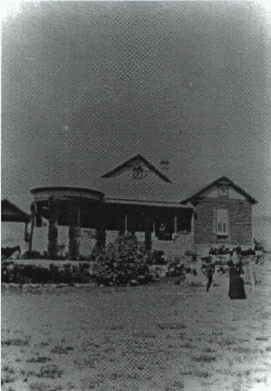
The Henry M. and Annie V. Trueheart House is a residence of historic significance located in the town of Fort Davis, the seat and largest town of Jeff Davis County in the U.S. state of Texas. The house was built in 1898 and, along with the surrounding property, was added to the National Register of Historic Places (NRHP) in 1996. The Trueheart House has also been distinguished as a Recorded Texas Historic Landmark (RTHL) since 1964.
Huizhou architecture is one of the traditional Chinese architecture styles, which prevailed mostly in the historical Huizhou prefecture of Anhui, China as a critical element of Huizhou culture. The architecture uses bricks, woods and stone as raw materials, timber frames as significant structures. The bearing structure is a wooden beam, and parapet walls are made of bricks, rocks, and soils. The central room is decorated with painted beams, sculpted roof, and carved eaves with skylights. The technical features and style of Hui-style architecture majorly occur in residential houses, ancestral temples, joss houses, archways, memorial gates, and gardens. The architecture reflects mountainous features of the area and a geomantic omen of traditional Chinese religions.

























